What is Passive RFID?
Passive RFID is a term used to describe RFID tags that do not have a battery or other internal power source. Instead of a battery, Passive RFID tags rely on the energy received from the RFID reader and its antenna for power. When the RFID reader scans the area for RFID tags, it sends out an electrical signal, which is converted into electromagnetic RF energy by the RFID antenna, and that energy is used to power the RFID tags in the read area. RFID tags need a very small amount of energy to power their internal RFID chip and send a response with the programmed information. To read more in depth about the physics involved in Passive UHF RFID, read our article "RF Physics: How Does Energy Flow in an RFID System?"
Because Passive RFID is a battery-free technology, the tags will never be reliant on battery power or restricted by the short lifespan of a small battery. Additionally, Passive RFID tags can be purchased for a very low cost - only a few cents for UHF RFID tags, which wouldn’t be possible if a battery was included in the tag. Active RFID is the exact opposite and is a type of RFID technology that uses a battery to power each RFID tag. Because each battery’s lifespan is limited, and the tags are much more expensive, the use of Active RFID is not as widely adopted as Passive RFID.
Passive RFID Frequencies
All radio waves/electromagnetic waves are emitted within a certain frequency range. For example, an FM radio receives radio waves emitted between 88 MHz - 108 MHz, and we can tune our radios to listen between certain frequencies in that range to find a specific station on a specific frequency. RFID operates in a similar way, except RFID readers automatically switch between frequencies within a certain range extremely quickly in order to pick up RFID tag responses on all available frequencies. There are three main frequency ranges used by Passive RFID systems - Low Frequency, High Frequency, and Ultra-High Frequency.
Low Frequency: Low Frequency (LF) RFID is emitted in the 30 - 300 kHz range, but most LF tags primarily operate on the 125 kHz band (specific frequency band) or the 134 kHz band. Because radio waves within this frequency range are only able to transmit a short distance (only a few inches) only one or two bands can be used without fear of one system interfering with another.
High Frequency: High Frequency (HF) RFID is emitted in the 3 - 30 MHz range, but most HF tags primarily operate on the 13.56 MHz band. Similar to LF, HF is a type of short range RFID, only able to transmit at a few inches and up to about a foot, so using one singular band works well. Near-Field Communication, or NFC, is a type of High Frequency RFID, which is extremely popular for data sharing and contactless payments.
Ultra-High Frequency: Ultra-High Frequency (UHF) RFID is emitted between 300 MHz and 3 GHz, but most UHF RFID tags transmit on the main range of 860 - 960 MHz, as well as on a less frequently used band of 433 MHz. The larger band of 860 - 960 is a global band that is further subdivided into smaller bands that are region specific. For example, the US operating region is limited to the 902 - 928 MHz range. To learn more about your country’s operating region and frequency band - read our article “How to Conform to Regional Regulations when using RFID”.
The different frequency ranges are very important because unlike AM/FM radios, which can receive radio waves in two distinct frequency ranges, UHF RFID readers can only communicate on one specific frequency range. If you have two RFID applications, and one is an HF/NFC application and the other is a UHF application - you would need two different RFID readers and two different types of Passive RFID tags.
Passive RFID Read Distance
The maximum read distance for Passive RFID systems allows the frequency ranges to be grouped into two groups - long range RFID and short range RFID. UHF RFID is the only frequency that fits into the long range RFID group, while HF/NFC and LF make up the short range RFID group.
Passive UHF RFID tags can generally be read on average about 20 - 30 feet in distance, depending on the tag size and environment. Smaller UHF RFID tags (usually inlays less than 2” in width) generally have a shorter range, somewhere between 3 - 5 feet. Passive UHF RFID tags, however, do not have the long range that Active tags or Battery-Assisted Passive RFID tags have, which can be anywhere from 50 - 250 feet of receive distance. The benefit of extremely long range RFID capabilities that Active tags and Battery-Assisted Passive tags is very often outweighed by the high cost per tag and limited lifespan.
Passive HF/NFC RFID tags can generally be read on average about 6 inches away, and Passive LF RFID tags can only be read at a maximum of 2-3 inches away. This is because both HF/NFC and LF tags are short range RFID technology that are powered by a magnetic field created between the reader and the RFID tag. To read more about magnetic (capacitve) coupling, read our article "Operating Principles: Coupling".
Passive RFID Tags
Passive RFID tags are available in the three most common Passive RFID frequency ranges - LF, HF, and UHF and are offered in two basic forms - inlays/labels and hard tags which have a protective casing. See below for some examples of different Passive RFID tags in the two available form factors.
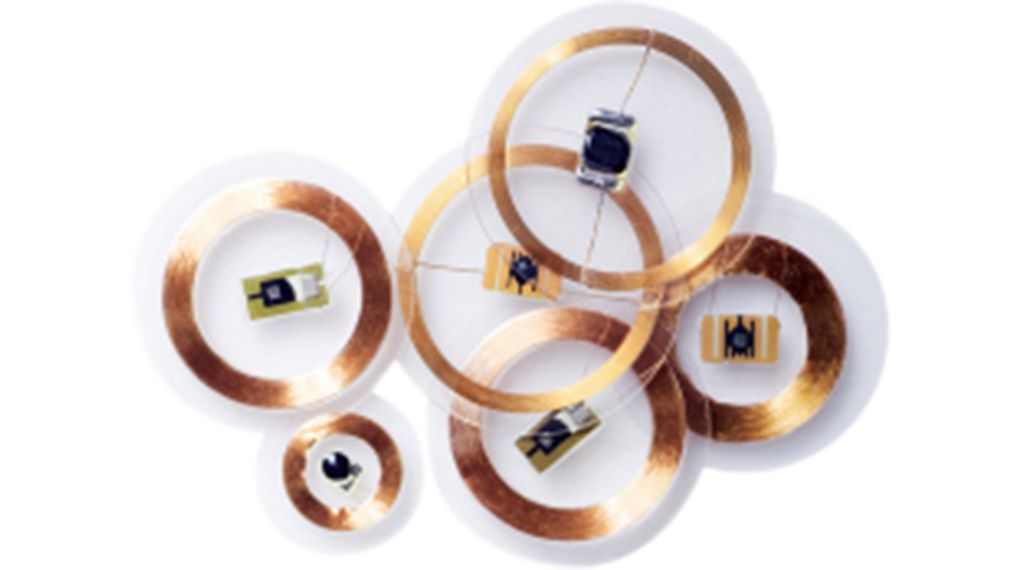
Passive LF RFID Tags can be circular inlays with a copper coil, as shown above, but they are typically in a keyfob or glass (animal tracking) embeddable capsule shown below.
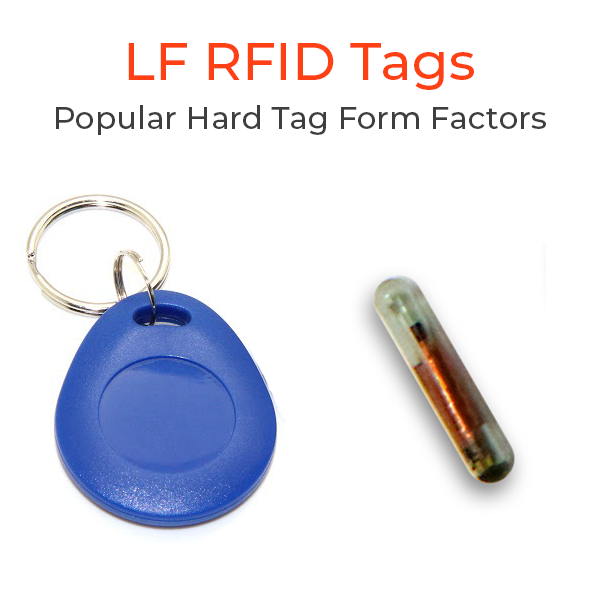
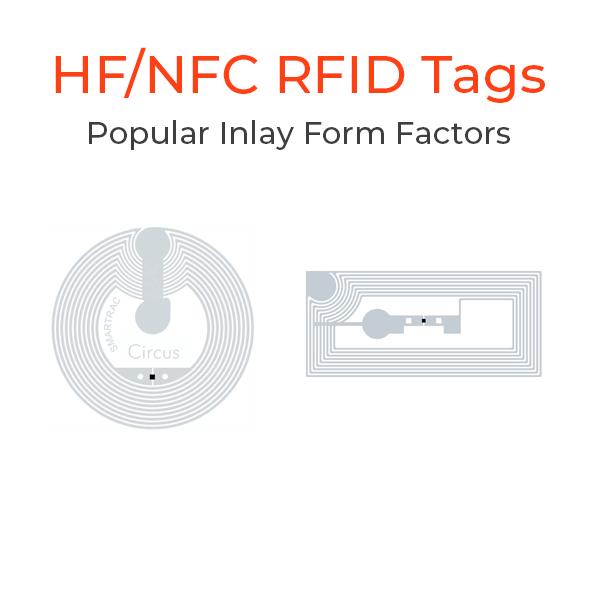
Passive HF/NFC RFID Tags are popular in both inlay and hard tag format. In inlay format they can either be square or circular with a metal coil, as shown above. In hard tag format, they are typically available in keyfob, plastic card, and plastic tag (miscellaneous) forms, as shown below.
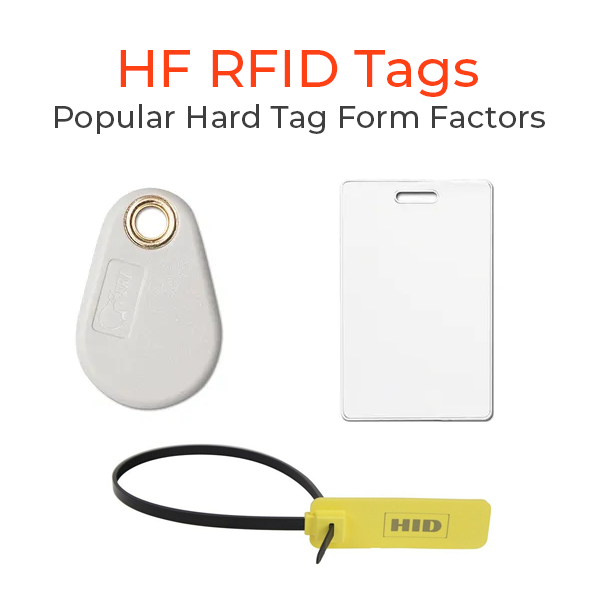
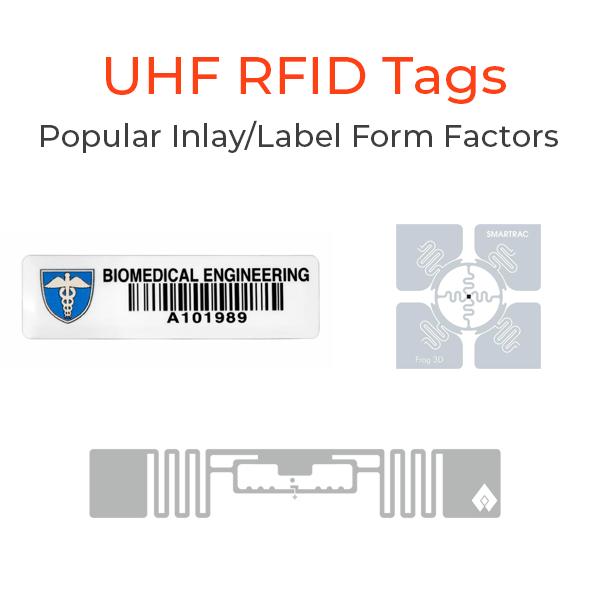
Passive UHF RFID Inlays/Labels, shown above, are available in rectangular or square form factors, and labels can be purchased with printed elements. Passive UHF RFID Hard Tags are available in rectangular, square, or circle form factors and some can be embedded in materials such as plastic or even garments, shown below.
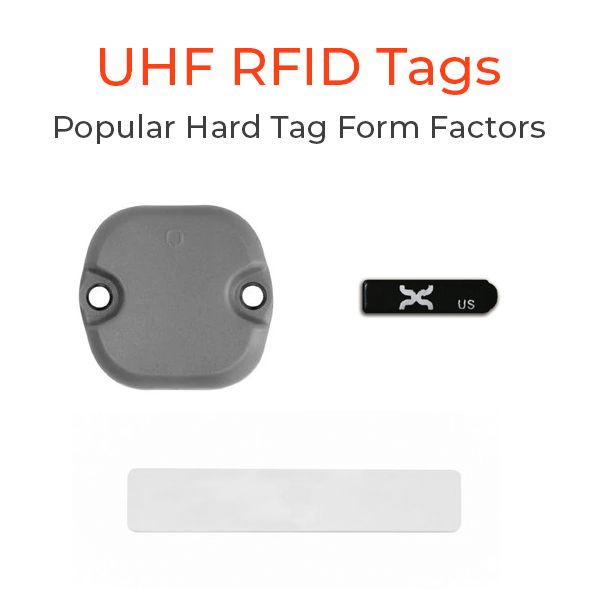
Passive tags have the ability to be made into inlays and labels, which are almost paper-thin, solely because they do not contain a battery. All Passive RFID tags can be activated by simply reading the RFID tag with a compatible RFID reader.
Passive RFID Applications
Because Active RFID is used less frequently than Passive, most RFID applications popular today are powered by Passive RFID tags and readers. Below is a list of Passive RFID applications and the frequency range being used for each one, categorized by popularity.
Most Popular
- Access Control - HF/NFC - Using RFID tags to restrict/allow access to buildings, parking lots, and neighborhoods
- Animal Identification - LF - Using RFID tags to identify pets and livestock
- Retail Inventory Management - UHF - Using RFID tags to take and manage retail inventory levels
- Tolling - UHF - Using RFID tags to identify toll passes in vehicles
Semi-Popular
- Race Timing - UHF - Using RFID tags to identify when racers cross the start/finish line
- Library Inventory Tracking - HF/NFC or UHF - Using RFID tags to manage library inventory and check in/out books
- Authentication - HF/NFC - Using RFID tags to authenticate shoes, vaccines, and other important items
- Asset Tracking - UHF - Using RFID tags to keep track of assets that move around in facilities
Up & Coming
- Work-in-Process (WIP) - UHF - Using RFID tags to keep track of specific items in the manufacturing process
- Logistics - UHF - Using RFID tags to document and track an item through all stages of transportation
- Food Industry - HF/NFC or UHF - Using RFID tags to manage inventory, allow for items to be purchased, prevent theft
- Pharmaceuticals - HF/NFC or UHF - Using RFID tags to manage inventory, authenticate medicine, and track medicine throughout the entire supply chain (simplify recalls)
Conclusion
For more information about Passive RFID, checkout our popular article - Passive vs Active RFID or contact us!
